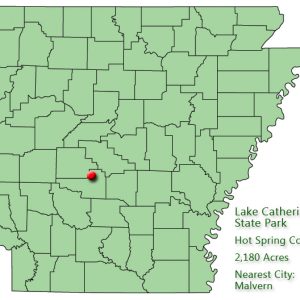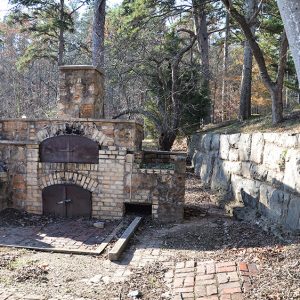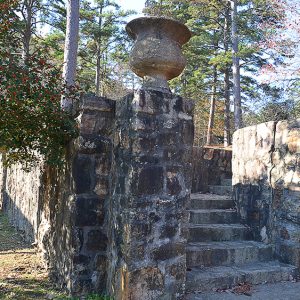calsfoundation@cals.org
Lake Catherine State Park Prisoner of War Structures
Construction of what are now known as the Lake Catherine State Park Prisoner of War Structures was started by the Civilian Conservation Corps (CCC) in the late 1930s and completed by German prisoners of war in 1945. Located at Lake Catherine State Park at 1200 Catherine Park Road in Hot Spring County, these structures—a 210-foot-long, nine-foot-tall stone retaining wall and an outdoor stone oven—were listed on the National Register of Historic Places on January 24, 2017.
Lake Catherine was created when Remmel Dam was completed on the Ouachita River in December 1924. In 1935, Arkansas Power and Light founder Harvey C. Couch donated more than 2,000 acres of land surrounding Lake Catherine to the State Parks Commission. Two years later, the State Parks Commission and National Park Service agreed to support development of Lake Catherine into a state park by establishing CCC Camp 3777.
CCC Camp 3777 began transforming the area into a usable tourism area by building roads, lodging, and picnic areas. CCC activities in the area ended in 1942 as funding was diverted to the war effort after the United States entered World War II.
In 1943, the United States began housing prisoners of war that British forces had taken during the North Africa Campaign of World War II. Many of the initial 173,000 prisoners were housed in the three large camps in Arkansas—Camps Chaffee (now Fort Chaffee), Robinson, and Monticello. Arkansas was an ideal state in which to house prisoners of war because it was both sparsely populated and in dire need of workers due to a farming labor shortage. After arriving at one of the main camps, most prisoners were sent to smaller branch camps located throughout the state. The branch camp at nearby Hot Springs (Garland County) was one of the few camps not located in a farming area.
The prisoners housed at the Hot Springs branch camp were German prisoners of war and were tasked with completing the previous CCC projects that had been left unfinished due to the war effort. The number of prisoners reached its peak May 8, 1945, with 213 imprisoned enlisted men guarded by about sixteen American soldiers.
The retaining wall and outdoor oven remain as the last structures at Lake Catherine State Park known to have been worked on by these prisoners of war. (The POWs worked on other projects while there, but no markings have been found on any other structures to identify them specifically as made by POWs.) The retaining wall was constructed out of native stone built up from a cast concrete foundation. A stone stairway was built into the wall, allowing easy movement from the top of the wall to the bottom. The wall is known to have been built by prisoners because of an etching of “P.W.” near the stone steps. The wall remains in good condition.
The outdoor oven’s main structure is also built out of native stone, with blond bricks surrounding the oven openings and grilling surfaces. The oven is surrounded by a patio made with bricks laid in a basket-weave pattern. Three grilling surfaces, made out of red bricks, protrude from the sides and back of the oven. An etching of “P.W. 1945” marks the oven, identifying it as made by prisoners. The oven has deteriorated over the years, with some loose bricks and missing grilling surfaces.
For additional information:
Ratermann, Travis A. “Arkansas Listings in the National Register of Historic Places: Prisoner of War Structures at Lake Catherine State Park.” Arkansas Historical Quarterly 79 (Summer 2020): 153–159.
———. “Lake Catherine State Park Prisoner of War Structures.” National Register of Historic Places nomination form. On file at Arkansas Historic Preservation Program, Little Rock, Arkansas. Online at http://www.arkansaspreservation.com/National-Register-Listings/PDF/HS0066andHS0270_nr.pdf (accessed December 30, 2020).
Jonathan R. Reinbold
University of Central Arkansas
 Historic Preservation
Historic Preservation World War II through the Faubus Era, 1941 through 1967
World War II through the Faubus Era, 1941 through 1967 Lake Catherine State Park: Park Location
Lake Catherine State Park: Park Location  Outdoor Stone Oven
Outdoor Stone Oven  Outdoor Stone Oven
Outdoor Stone Oven  Retaining Wall
Retaining Wall 




German POWs housed at Lake Catherine Park were hauled on open trucks to work at brick factories in Malvern. POWs had money and on this work trip regularly bought contraband beer from local kids, my cousin Henry McMillan Jr. being one. Henry grew up to a teen on the Ouachita River in the Saginaw/Social Hill/ Malvern area. Henry finished college and went to work in a lab as a chemist for Reynolds, finishing his career for Reynolds in Venezuela because of his college study of Spanish language. Henry McMillan Jr. is also a great-grandchild of Belle McLean and Col. Daniel Morrison of the Morrison Plantation at Saginaw listed on the National Register and greatly endangered.
Also, kids born in 1947 recall this park always being called “Vets Haven” and “Vets Haven Pocket.” We knew it by no other name than Vets Haven.